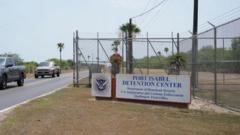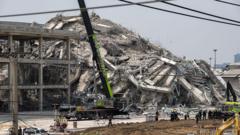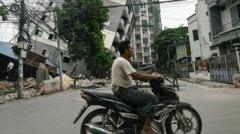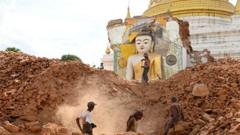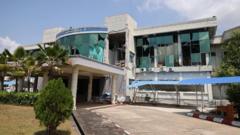As Bangkok and Mandalay grapple with the aftermath of a powerful earthquake, the region's resilience—and the future of urban construction—hangs in the balance.
# Earthquake Shakes Myanmar and Thailand: A Wake-Up Call for Structural Safety

# Earthquake Shakes Myanmar and Thailand: A Wake-Up Call for Structural Safety
In the wake of a major earthquake, concerns over building safety rise as traditional norms are challenged.
On March 30, 2025, a magnitude 7.7 earthquake centered in Myanmar sent shockwaves that were felt across the border in Thailand. For Kanittha Thepasak, a Bangkok resident, what began as a dizzy spell quickly escalated into sheer panic as the ground moved violently beneath her feet. Upon witnessing her neighbors flee their high-rise apartments, her fears only heightened. “I’m freaked out, I’m worried,” she shared, highlighting the lack of earthquake preparedness among locals in a country where such tremors are uncommon.
While the earthquake caused significant devastation in Myanmar, including widespread destruction, Thailand experienced a relatively mild outcome. However, the psychological impact was severe, leading many to rush outside in search of safety amidst the towering structures that define Bangkok’s skyline. Buildings, glass offices, and ongoing construction projects became sources of trepidation rather than comfort, as citizens braced for potential aftershocks.
Perhaps the most tragic event in Thailand resulted from the collapse of an under-construction building in Bangkok, which claimed the lives of at least 11 workers. Emergency response teams are still actively working at the site, with over 76 individuals reported missing. Utilizing excavators and trained dogs, rescuers are combing through the debris—hoping to find survivors or recover the deceased.
The episode serves as a grave reminder of the importance of seismic safety in urban planning, especially as cities grow taller and more populated. In the aftermath of this disaster, questions loom about building regulations and the preparedness of construction teams to withstand natural calamities. This event has now awakened Bangkok’s population to reevaluate their reliance on high-rise living, where potential dangers were previously underestimated.
As investigations into building standards and safety protocols unfold, both Myanmar and Thailand face an urgent need to implement stronger measures to ensure community safety in the event of future seismic activities. For cities built on ambitions of economic growth, this earthquake may serve as a catalyst for essential change in structural integrity and public awareness.

